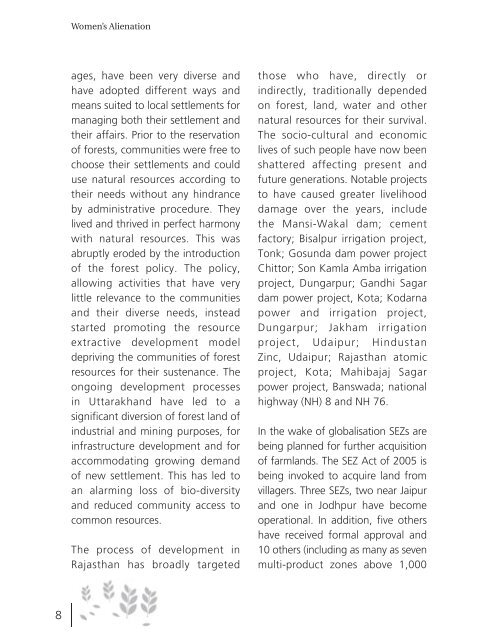om e 's Ali a - Land ss De elo en - Friedrich-Ebert-Stiftung, India Office
om e 's Ali a - Land ss De elo en - Friedrich-Ebert-Stiftung, India Office
om e 's Ali a - Land ss De elo en - Friedrich-Ebert-Stiftung, India Office
Create successful ePaper yourself
Turn your PDF publications into a flip-book with our unique Google optimized e-Paper software.
8<br />
W<strong>om</strong><strong>en</strong>’s <strong>Ali</strong><strong>en</strong>ation<br />
ages, have be<strong>en</strong> very diverse and<br />
have adopted differ<strong>en</strong>t ways and<br />
means suited to local settlem<strong>en</strong>ts for<br />
managing both their settlem<strong>en</strong>t and<br />
their affairs. Prior to the reservation<br />
of forests, c<strong>om</strong>munities were free to<br />
choose their settlem<strong>en</strong>ts and could<br />
use natural resources according to<br />
their needs without any hindrance<br />
by administrative procedure. They<br />
lived and thrived in perfect harmony<br />
with natural resources. This was<br />
abruptly eroded by the introduction<br />
of the forest policy. The policy,<br />
allowing activities that have very<br />
little relevance to the c<strong>om</strong>munities<br />
and their diverse needs, instead<br />
started pr<strong>om</strong>oting the resource<br />
extractive dev<strong>elo</strong>pm<strong>en</strong>t model<br />
depriving the c<strong>om</strong>munities of forest<br />
resources for their sust<strong>en</strong>ance. The<br />
ongoing dev<strong>elo</strong>pm<strong>en</strong>t proce<strong>ss</strong>es<br />
in Uttarakhand have led to a<br />
significant diversion of forest land of<br />
industrial and mining purposes, for<br />
infrastructure dev<strong>elo</strong>pm<strong>en</strong>t and for<br />
acc<strong>om</strong>modating growing demand<br />
of new settlem<strong>en</strong>t. This has led to<br />
an alarming lo<strong>ss</strong> of bio-diversity<br />
and reduced c<strong>om</strong>munity acce<strong>ss</strong> to<br />
c<strong>om</strong>mon resources.<br />
The proce<strong>ss</strong> of dev<strong>elo</strong>pm<strong>en</strong>t in<br />
Rajasthan has broadly targeted<br />
those who have, directly or<br />
indirectly, traditionally dep<strong>en</strong>ded<br />
on forest, land, water and other<br />
natural resources for their survival.<br />
The socio-cultural and econ<strong>om</strong>ic<br />
lives of such people have now be<strong>en</strong><br />
shattered affecting pres<strong>en</strong>t and<br />
future g<strong>en</strong>erations. Notable projects<br />
to have caused greater livelihood<br />
damage over the years, include<br />
the Mansi-Wakal dam; cem<strong>en</strong>t<br />
factory; Bisalpur irrigation project,<br />
Tonk; Gosunda dam power project<br />
Chittor; Son Kamla Amba irrigation<br />
project, Dungarpur; Gandhi Sagar<br />
dam power project, Kota; Kodarna<br />
power and irrigation project,<br />
Dungarpur; Jakham irrigation<br />
project, Udaipur; Hindustan<br />
Zinc, Udaipur; Rajasthan at<strong>om</strong>ic<br />
project, Kota; Mahibajaj Sagar<br />
power project, Banswada; national<br />
highway (NH) 8 and NH 76.<br />
In the wake of globalisation SEZs are<br />
being planned for further acquisition<br />
of farmlands. The SEZ Act of 2005 is<br />
being invoked to acquire land fr<strong>om</strong><br />
villagers. Three SEZs, two near Jaipur<br />
and one in Jodhpur have bec<strong>om</strong>e<br />
operational. In addition, five others<br />
have received formal approval and<br />
10 others (including as many as sev<strong>en</strong><br />
multi-product zones above 1,000


